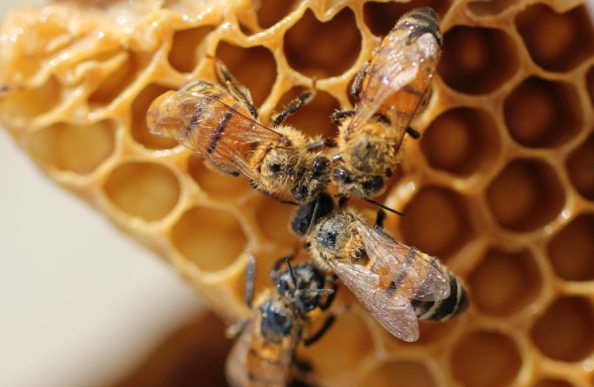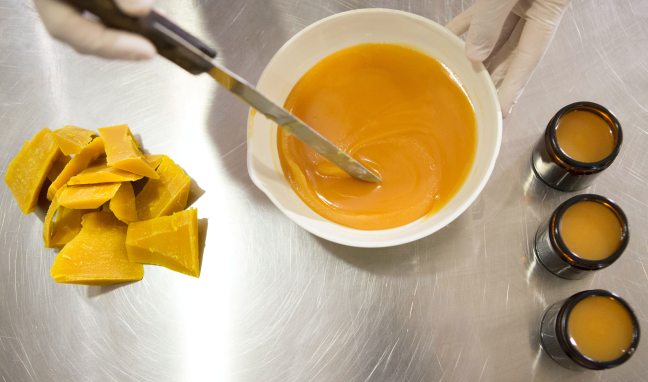Before we dive into the main question, let’s discuss a few interesting facts about beeswax:
- For starters, it’s beeswax and not bees’ wax. It’s one word. And what is beeswax? Simply put, it’s wax made by bees.
- Wax was initially only applied to the wax secreted by Apis mellifera, the European honey bee. And the word ‘wax’ was actually drawn from ‘weax’, an Old English word.
- Beeswax and honey were both used in ancient medicine; specifically in creams and ointments for wounds and burns.
- The wax made by Asian honey bees is more acidic than the wax made by European honey bees.
- There are 3 types of beeswax; yellow (raw beeswax), white (bleached yellow beeswax), and beeswax absolute (contains alcohol).
- Although beeswax is initially colorless, it grows opaque after chewing and after adding honey, pollen, and propolis.
- In order for bees to produce 1 pound of beeswax, they must consume 6 to 8 pounds of honey.
Now, coming to the main question.
How do honey bees make wax?
Only female worker bees produce wax.
This wax is secreted from the wax glands present on the underside of the bee’s abdomen. Beeswax is normally produced when the worker bees are between 12 to 18 days of age.
As the bees grow older, these glands that produce wax reduce in size. When this happens, the bees take on other responsibilities like foraging.
Want a closer look into beeswax? I’ve found something you might like to read!

Why do bees make wax?
When young bees secrete liquid wax, it gets in contact with the air and solidifies to form small shapes. These shapes are then modeled by other worked bees (using their mandibles) to build honeycombs.
Additionally, bees make wax to compose the cells where eggs are laid to rear young bees.
When do bees make wax?
Beeswax is normally made between April and June. Beeswax production is dependent on the following factors:
- Egg laying: If a colony is active and consists of a queen in each cell, it means more wax must be created by the worker bees to create the comb for more bee rearing.
- Nectar flow: When there’s more nectar flowing into the hive or nest, bees will need more place to store it. When this need arises, they will need to produce more wax to build combs.
- Temperature: Warmer the temperature, the easier it is for bees to produce wax.
- Queen’s presence: Bees produce wax only if their colony has a queen.
Is beeswax edible?
Can you eat beeswax? Yes! Beeswax is 100% edible.
You might like to learn more about this here.
What can you do with beeswax? (uses)
What to do with honeycomb wax? Honey bee wax is said to help reduce cholesterol, fungal skin infections and pain. However, there is insufficient scientific research to support these uses. (Psst: here’s an article on how beeswax lowers both pain & cholesterol)
Beeswax is also used in food and beverages as a stiffening agent, when treated with alcohol.
In cosmetics, beeswax is used as an emulsifier and thickener. It is also used as a fragrance in perfumes and soaps, and to polish pills, and it is also said to reduce skin problems. (curious? I was too. So I found this book that might interest you!)

Check out these 3 recipes that use beeswax to heal dry skin:
- Beeswax body butter
Ingredients:
1/8 cup cocoa butter
2-1/2 ounces beeswax
1/8 cup palm oil
1/4 cup coconut oil
1/2 teaspoon or 1 gel tablet of vitamin E oil
1/2 teaspoon essential oil
Steps:
- Place a double boiler on the gas. It should consist of a pan and a mason jar placed inside the pan.
- Place all your ingredients inside the mason jar and heat them. (Except the essential oil and vitamin E oil)
- Remove the above mixture from the heat and add in the remaining ingredients that you skipped. And it’s done!
- Beeswax lip balm
Ingredients:
7 ounces coconut oil
4 ounces beeswax
1-1/2 tablespoons essential oil
Mix all these ingredients and you’re done!
- Beeswax perfume
Ingredients:
2 tablespoons jojoba oil or coconut oil
30 drops of each of any 3 essential oils
Steps:
- Heat the beeswax along with your jojoba or coconut oil in a double boiler.
- Once melted, remove this mixture from the heat and add in your essential oils. That’s all!
Beeswax is also used in hair products to moisturize the hair and make it grow quickly.
Beeswax is an effective lubricant and can be used on stuck windows, old furniture and sliding doors.
What is beeswax made of?
Beeswax consists of:
- Alkanes
- Alkenes
- Free fatty acids
- Monoesters
- Diesters
- Hydroxymonoesters
- Fatty alcohols
- Hydroxydiesters
Harvesting beeswax: how do you do it?
The process of harvesting beeswax includes using a heating knife to remove wax cappings.
Then, you must place these wax cappings inside a container with tiny holes at the bottom. This container should be placed on top of another container so that it can collect the dripping honey from the cappings. This beeswax can even be rinsed with cold water.
Make sure to harvest your beeswax far away from the beehive.
In order to harvest beeswax, you must also filter it. The goal of filtering is to remove any debris or bee parts from the wax.
So how do you filter beeswax?
- Use a double boiler or simply place a stainless bowl inside boiling water.
- Filter the debris from the wax using a woven cloth and direct it into a bowl.
- Place parchment paper (which serves as a mould) at the bottom of the bowl to harden the wax.
- Then, pour your melted beeswax inside the silicone molds after you have filtered it.
Although harvesting beeswax is done quite frequently, it is still not recommended. Why? Because beeswax is majorly produced for the beehive. For this reason, it is best to harvest only what is in surplus.
Read here: How to Extract Honey from Honeycomb
However, I found an article that claims it’s not morally wrong to take honey from bees. What are your views on this?
Read here more:-